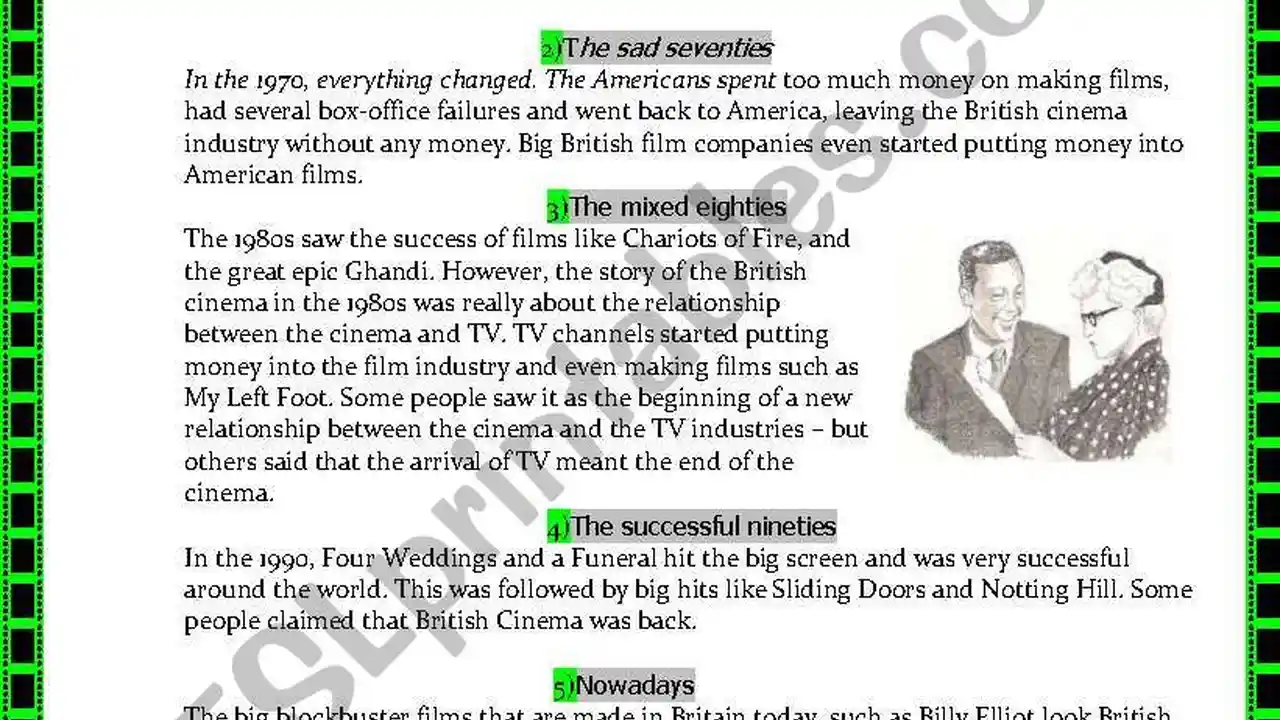The History of British Cinema: A Guide
Sample meta description.

A Journey Through Time Exploring British Film History
Alright, film buffs, gather 'round! We're diving deep into the captivating world of British cinema, from its humble beginnings to its current global influence. Forget stuffy history books; we're talking about the movies, the stars, the scandals, and everything in between. Get ready for a whirlwind tour!
The Silent Era Laying the Foundation for British Film
It all started way back when talking pictures were just a twinkle in some inventor's eye. The silent era was a wild west for filmmakers, a time of experimentation and innovation. Think flickering images, dramatic gestures, and musical accompaniment that set the mood. British studios were popping up, experimenting with narratives and visual storytelling. While overshadowed by early American cinema to some extent, early British filmmakers were laying the groundwork for what was to come. Key figures like Cecil Hepworth, with his "Rescued by Rover" (1905), showcased the potential of film for emotional storytelling. This era was all about visual communication, and British filmmakers were learning fast.
The Rise of Sound British Cinema Finds Its Voice
Then came the talkies! Suddenly, movies had voices, and British cinema found its own. Alfred Hitchcock, a name synonymous with suspense, began his career in Britain during this period. His early work, like "The 39 Steps" (1935), showcased his developing mastery of tension and visual storytelling. Sound allowed for new genres to flourish, and British comedies and dramas began to gain popularity. The industry was booming, and British actors and actresses were becoming household names.
World War II and Post-War Realism Reflecting a Nation
World War II had a profound impact on British cinema. Films became tools for propaganda, morale-boosting, and documenting the realities of war. After the war, a wave of social realism swept through British cinema. Films like "Brief Encounter" (1945) and "The Third Man" (1949) explored the emotional and social landscape of a nation recovering from conflict. These films were often gritty, realistic, and deeply moving, reflecting the experiences of ordinary people. The post-war era saw a renewed focus on British identity and the challenges of rebuilding a society.
The British New Wave Challenging the Status Quo
In the late 1950s and early 1960s, the British New Wave emerged, challenging the traditional conventions of British cinema. This movement was characterized by its gritty realism, its focus on working-class life, and its social commentary. Films like "Saturday Night and Sunday Morning" (1960) and "A Taste of Honey" (1961) offered a stark and unflinching look at the lives of young people in post-war Britain. The New Wave was a breath of fresh air, injecting a new sense of energy and authenticity into British cinema. It also paved the way for future generations of filmmakers to push boundaries and challenge the status quo.
The Swinging Sixties and Beyond British Cinema Goes Global
The 1960s were a time of cultural revolution, and British cinema was right in the thick of it. Films like "Blow-Up" (1966) and "Alfie" (1966) captured the energy and excitement of the Swinging Sixties. British actors like Sean Connery and Michael Caine became international stars, and British films began to gain a wider global audience. The decade saw an explosion of creativity and experimentation, with British filmmakers pushing the boundaries of genre and style. From spy thrillers to social dramas, British cinema was making its mark on the world stage.
The 1980s and 1990s Revival and Reinvention
The 1980s and 1990s saw a revival of British cinema, with films like "Chariots of Fire" (1981) and "The Crying Game" (1992) winning critical acclaim and box office success. This period also saw the emergence of new talent, including directors like Mike Leigh and Ken Loach, who continued to explore social and political issues in their films. British cinema was reinventing itself, blending traditional storytelling with contemporary themes. The success of these films helped to revitalize the industry and attract new investment.
The 21st Century British Cinema Today
Today, British cinema is thriving. From blockbuster franchises like Harry Potter to independent gems like "Paddington", British films are entertaining audiences around the world. British actors, directors, and writers are in high demand, and British studios are attracting major international productions. The industry is diverse, innovative, and constantly evolving. British cinema continues to reflect the changing face of Britain and to tell stories that resonate with audiences of all backgrounds.
Gear Up Your Home Cinema Must-Have Products for the Ultimate British Film Experience
Now, let's talk about enhancing your viewing experience. To truly immerse yourself in the world of British cinema, you need the right gear. Here are a few recommendations to elevate your home cinema setup:
Sony Bravia XR-65A95L QD-OLED TV Immersive Viewing for British Blockbusters
Product: Sony Bravia XR-65A95L 65-inch QD-OLED TV
Use Case: Watching visually stunning British films like "1917" or "Blade Runner 2049" (partially filmed in the UK). The QD-OLED technology delivers vibrant colors, deep blacks, and exceptional contrast, bringing these films to life.
Comparison: Compared to a standard LED TV, the XR-65A95L offers significantly better picture quality, especially in dark scenes. While LED TVs struggle to achieve true blacks, the OLED technology allows each pixel to emit its own light, resulting in perfect blacks and infinite contrast. Compared to other OLED TVs, the QD-OLED technology offers improved color brightness and wider viewing angles.
Price: Approximately $3,500.
Sonos Arc Premium Soundbar Cinematic Audio for Every British Movie
Product: Sonos Arc Premium Smart Soundbar
Use Case: Enhancing the audio experience of dialogue-heavy British dramas like "The King's Speech" or action-packed thrillers like "James Bond". The Arc delivers clear, immersive sound, bringing the dialogue and sound effects to life.
Comparison: Compared to the built-in speakers of most TVs, the Sonos Arc offers a significant improvement in audio quality. It features Dolby Atmos technology, which creates a three-dimensional soundstage, making you feel like you're right in the middle of the action. Compared to other soundbars, the Sonos Arc is easy to set up and integrate with other Sonos products.
Price: Approximately $900.
Epson EpiqVision LS12000 Projector Big Screen British Cinema at Home
Product: Epson EpiqVision LS12000 4K PRO-UHD Laser Projector
Use Case: Creating a truly cinematic experience for watching epic British films like "Lawrence of Arabia" or "Doctor Zhivago." The projector delivers a large, vibrant image, transforming your living room into a home theater.
Comparison: Compared to a TV, a projector offers a much larger screen size, creating a more immersive viewing experience. The Epson LS12000 uses laser technology, which delivers brighter and more accurate colors than traditional lamp-based projectors. Compared to other projectors, the LS12000 offers excellent image quality and a long lifespan.
Price: Approximately $5,000.
Bowers & Wilkins 606 S3 Bookshelf Speakers Audiophile Sound for British Film Scores
Product: Bowers & Wilkins 606 S3 Bookshelf Speakers
Use Case: Experiencing the rich and nuanced soundtracks of British films like "The English Patient" or "Atonement" in their full glory. These speakers deliver exceptional sound quality, allowing you to hear every detail of the music.
Comparison: Compared to cheaper bookshelf speakers, the Bowers & Wilkins 606 S3 offer significantly better sound quality, with a wider frequency response and more accurate sound reproduction. They are designed for audiophiles who demand the best possible sound quality.
Price: Approximately $900 per pair.
Philips Hue Play Gradient Lightstrip Immersive Lighting for Every British Scene
Product: Philips Hue Play Gradient Lightstrip
Use Case: Adding a touch of ambiance to your viewing experience by synchronizing the lighting with the colors on the screen. This creates a more immersive and engaging experience, especially for visually stunning British films like "Life of Pi" (partially filmed in the UK).
Comparison: Compared to static lighting, the Philips Hue Play Gradient Lightstrip dynamically changes color to match the content on the screen, creating a more immersive and engaging experience. It is easy to set up and integrate with other Philips Hue products.
Price: Approximately $200.
:max_bytes(150000):strip_icc()/277019-baked-pork-chops-with-cream-of-mushroom-soup-DDMFS-beauty-4x3-BG-7505-5762b731cf30447d9cbbbbbf387beafa.jpg)






